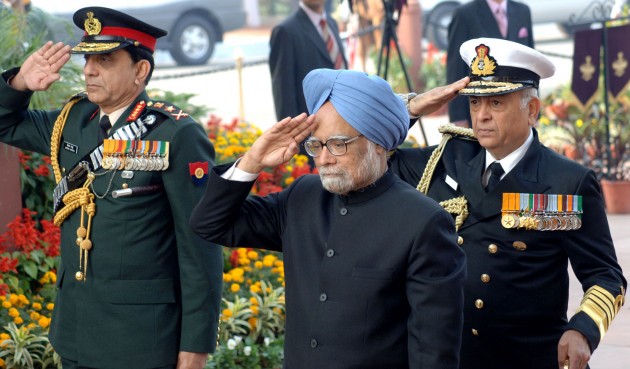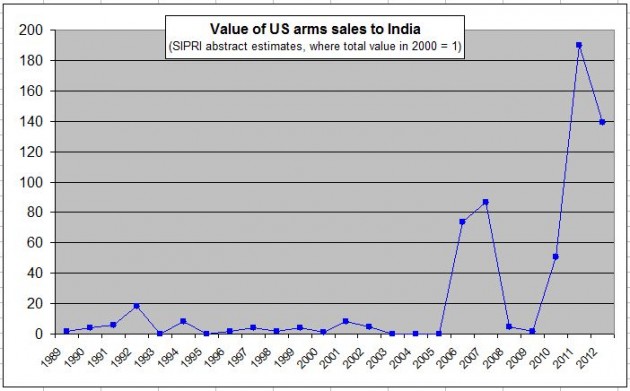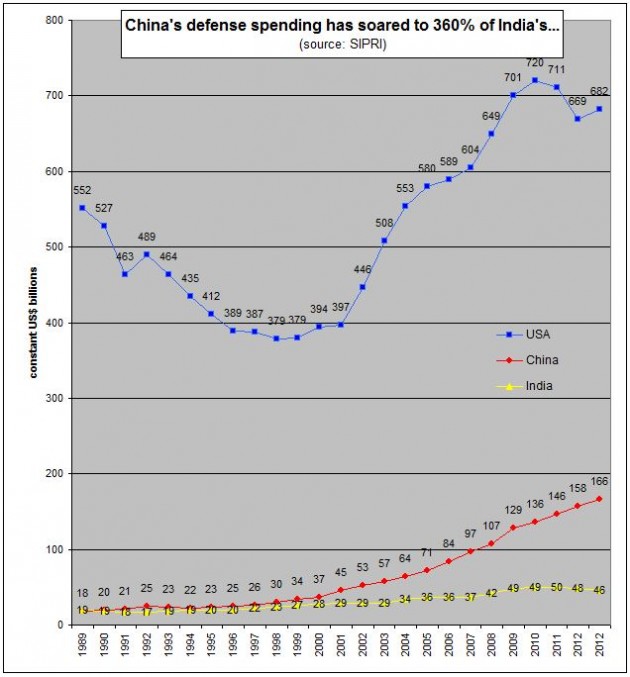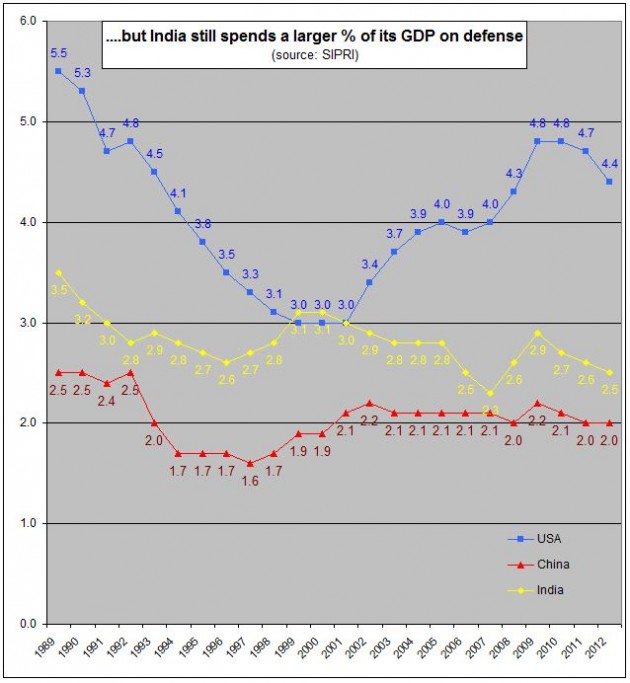Mr. Singh Comes To Washington: India, China & The Pacific
Posted on

India’s Prime Minister Manmohan Singh (center), seen here at a military review, will meet with President Obama on Friday.
WASHINGTON: When Indian prime minister Manmohan Singh meets with President Obama at the White House this Friday, the rise of China may not be on the official agenda, but it will be on everybody’s mind – and Beijing will be watching warily.
Friday’s meeting will be just the latest in a series of summits that began with George W. Bush – whose first term, not coincidentally, started with a pre-9/11 crisis over China’s downing of a US Navy spy plane off Hainan. Relations have kept getting closer ever since the Bush administration elevated India to the ranks of our most important allies. India has been the world’s biggest arms importer for the last four years in a row, and the value of its purchases from the US has soared since their nadir of zero in 2004-2005, according to the Stockholm International Peace Research Institute, SIPRI.

India’s navy is buying Boeing’s P-8 patrol plane, while their air force flies Boeing C-17 and Lockheed C-130 cargo aircraft (although it passed on F-16 and F-18 fighters in favor of France’s Rafale, with the Russian Sukhoi Su-30 reportedly the backup option if the Rafale deal falls through). The two countries’ militaries regularly exercise with one another, especially at sea. There is even talk of regular “rotations” of US Air Force units through the Indian airbase at Trivandrum, similar to the US Marine Corps’ long-term but not permanent presence in Darwin, Australia, which already gives Beijing the heebie-jeebies.
The growing closeness of Washington and New Delhi is bad news for Beijing, whose leaders fear “encirclement” by hostile powers. Ironically, that fear may well become a self-fulfilling prophecy because of China’s own increasing aggressiveness towards its neighbors, from Japan to the Philippines to India itself.
Just this April, Chinese soldiers crossed into Indian-claimed territory in the Himalayas and camped out in Indian-claimed territory for three weeks. The move so thoroughly provoked Indian nationalists ahead of a visit by China’s new premier that some observers speculated PLA commanders were acting without Beijing’s approval, perhaps in a deliberate attempt to scuttle any Sino-Indian détente. On the Indian side, just eight days ago, India staged a new test of its first ballistic missile with enough range to drop a nuclear warhead on Beijing, the Agni V, a weapon some Indian hawks have dubbed “the China-killer.”
Meanwhile, US-India relations grow warmer. Obama and Singh themselves have met three times already: in Washington in 2009, in New Delhi in 2010, and in Bali in 2011. Just this July, Vice-President Joe Biden and Army Chief of Staff Gen. Ray Odierno both visited India. Deputy Secretary of Defense Ash Carter was there last week. He not only touted US arms sales but also proposed that the US and India co-develop the next-generation of the Javelin anti-tank missile, built by Raytheon and Lockheed Martin. He even advertised new “priority funding” incentives to encourage US and Indian researchers to collaborate: “That’s something we’ve only ever done before with the United Kingdom and Australia,” Carter told reporters in New Delhi just five days ago.
But Carter’s visit also highlighted the limits of the US-India defense relationship. The proposal to jointly develop the new Javelin, for example, follows on earlier US offers to build production sites in India for the existing Javelin, the MH-60 helicopter, a naval gun, and a minelaying system. New Delhi is still thinking about it. Tellingly, the two countries can’t even agree on what the “T” stands for in a partnership called “DTI”: Washington says “Defense Trade Initiative,” to emphasize the US selling arms to India, while New Delhi calls it the “Defense Technology Initiative,” to emphasize the US transferring new technology to India. Meanwhile, US and Indian diplomats are rushing to finalize a civilian nuclear power deal — signed with great fanfare five years ago but never implemented — in time for Singh’s visit on Friday.
As much as hawks in both the US and India would like their countries to jointly contain China, there are reasons India will be cautious. The issue is not so much on the US side, despite the Pentagon’s repeated protests that, as Carter said in New Delhi last week, “the rebalance is not aimed at China.” In fact, under Carter’s leadership, the Pentagon has overridden the State Department’s reluctance to sell advanced weaponry to India, just as Bush overturned the sanctions put in place to punish India for its 1998 nuclear tests. But on the Indian side there are still deep-rooted obstacles: a six-decade commitment to “non-alignment,” an arsenal largely built with Russian weapons (“We don’t have the history that Russia does here,” Carter acknowledged), and sheer institutional inertia have slowed New Delhi’s response to US offerings. Indeed, arms sales to India can take decades to finalize, when the seller is lucky.)
The Elephant Dance: Engaging India Without Unnerving China
It makes no strategic sense to discuss one of Asia’s rapidly growing giants without considering the other. When US strategists talk about the rise of China in the West Pacific, India is the elephant in the room next door. Conversely, when America courts the world’s largest democracy, you can bet it’s seen with some suspicion by the authoritarian superpower across the Himalayas. Any engagement with one will create a reaction in the other – and as with any maneuver involving elephants, a great deal of delicacy is required.
So how can the US cultivate India without alarming China? “I don’t think that’s possible,” said Carl Baker, director of programs for the Pacific Forum at the Center for Strategic and International Studies (CSIS). “There’s always been sort of a strategic tension between the two,” he said. Points of friction: the two nation’s nuclear arsenals; China’s support of Pakistan; India’s support for Tibet’s exiled Dalai Lama; the disputed Himalayan border over which the two countries fought a brief war in 1962; and, increasingly, overlapping maritime ambitions in the Indian Ocean and South Pacific.
So Beijing is naturally leery of US-Indian cooperation, especially the increase in recent years in arms sales, joint exercises, and high-level military meetings. US officials, of course, make haste to dispute that.
“Our [goal] is not to go contain China,” insisted Gen. Odierno, speaking at CSIS on his return from a visit to India in July. (It was his first as America’s top Army officer but the second in his career). “Containment is having large land forces stationed forward,” Odierno said, which America does not intend and India would not permit. But US forces regularly visit India and the India Ocean for joint exercises and may start regular deployments to the airbase at Trivandrum. So the general’s definition of “containment” conveniently ignores much of what the Chinese, like the Soviets before them, might consider “encirclement.”
“This policy is not excluding China,” Odierno insisted. “It’s to work with China [to] ensure that we don’t get into conflict, we don’t build animosities between all the major power in the Asia-Pacific.”
Just as the Chinese have their anxieties about the US and India, however, the Indians have deep doubts about the Chinese that no amount of American diplo-speak can smooth over. Those doubts date back to a border war the two countries fought in the Himalayas 51 years ago, a humiliation for India that the Chinese barely remember but which Indian patriots cannot forget.
“When I was in India last year [to meet] high-level [defense] officials,” recalled Pentagon strategist and Georgetown University professor Oriana Mastro, “we spent the whole time speaking about the 1962 war.” (Mastro recounted this story at a Carnegie Endowment panel in June on “India’s naval rise”). The next week, she travelled to China and couldn’t find a single text on the border war in “the biggest bookstore in Beijing,” she said. When she asked the staff to help her, she got this incredulous response: “We fought a war with India in 1962?”
Yet for Indian policymakers and elites, that half-century-old trauma has shaped their view of China ever since.
India vs. China, By Land Or By Sea?
It is essential to realize just how different the world looks from New Delhi. From the US perspective looking across the vast Pacific, for example, a hypothetical hostile China is primarily a naval problem: The Pentagon concept that de facto focuses on conflict with China is even called “Air-Sea Battle.” From an Indian perspective looking across the Himalayas, however, Chinese hostility is hardly hypothetical, and it’s an entirely terrestrial border dispute – assuming that neither side starts flinging nukes.
While Pakistan has always been India’s primary threat, China steamrollered India in 1962 and the Himalayan boundary remains disputed to this day, with regular Chinese incursions. Just this April, People’s Liberation Army troops marched 12 miles into Indian-claimed territory and set up camp there for three weeks, watched warily by Indian soldiers.
“As it is in many of the Asia-Pacific countries, the army is the dominant service” in India, Gen. Odierno noted pointedly. “It is by far the largest service, it is by far the most influential.”
In contrast to how US defense spending is divided into roughly equal shares for each military department (Army, Air Force, and Navy/Marines), the Indian Army historically consumes more than half of India’s defense spending. In the proposed 2013-2014 budget, the Army share shrank slightly, but it still gets 49 percent. The Air Force is a distant second at 28 percent, despite years of steady growth, and the Indian Navy actually shrinks to under 18 percent. (The remaining 5 percent goes to defense-wide activities, primarily research and development).
“The Chinese-Indian confrontations are all on land,” said Norman Polmar, a leading naval historian and analyst. “There’s no naval confrontation between the two because there’s no naval intersection between the two.”
That could change, however, as both Beijing and New Delhi increase their naval capabilities and ambitions. “The land border [is] a source of irritation, but I don’t think that’s what drives the real competition, ” said CSIS’s Baker, disagreeing with Polmar. “I think the competition ultimately is maritime.”
In the oil-rich and much-contested South China Sea, for example, an Indian company is backing Vietnamese exploration of areas claimed by China. Last year India’s top admiral, D.K. Joshi, went so far as to say his fleet stood “prepared” to defend India’s energy interests there. It was a dubious claim in terms of the Indian military’s actual ability to intervene – Baker dismisses it as “bluster” – but it still that provoked a harsh Chinese response.
For China’s part, the People’s Republic depends on the uninterrupted flow of Middle Eastern oil eastwards across the Indian Ocean and through the Strait of Malacca. (So do US allies like Japan and South Korea). Growing Chinese investments in ports around the region – in Pakistan, Sri Lanka, and Myanmar (Burma) – have spurred Indian anxieties about being encircled by a Chinese “string of pearls.”
“Indeed,” scholar Iskander Rehman wrote wrily in 2012, “a first-time traveler to India could be forgiven for believing that India is on the verge of being subjected to a sudden wave of Chinese amphibious landings.” Now a fellow at the Center for Strategic and Budgetary Assessments, Rehman is deeply skeptical about potential Sino-Indian naval conflict. He emphasizes that India’s chief maritime problem remains Pakistan, from whose shores sailed the perpetrators of the 2008 Mumbai attack.
That said, the Indian Navy has never been a mere coastal defense force and lately “has been pursuing an ambitious and impressive modernization program,” Rehman told me. The goal: “a 160 ship fleet, with 300 aircraft, structured around three carrier groups, by 2022.” (By comparison, the US Navy has ten carriers – a historic low – and over 3,700 aircraft).
India’s ambitions, however, often exceed its grasp. Currently, India has a single geriatric carrier, an ex-Royal Navy ship first laid down in World War II. But it has bought the unfinished Soviet carrier Gorshkov (a smaller cousin to China’s carrier, the ex-Soviet Varyag, which has not yet entered service). The refurbished carrier should – after much delay – enter Indian service as the Vikramaditya this year, equipped with Russian-built MiG-29K fighters that far outclass India’s current Harrier jumpjets. Two Indian-designed carriers are also in the works, but they are even more delayed, and Rehman predicts the first won’t enter service “until 2018 at the earliest.”
India also has two nuclear-powered submarines – one Russian import and one built domestically – and a dozen conventionally powered ones, with ambitious plans for a fleet of five ballistic-missile subs as a nuclear deterrent. It is also building a variety of corvettes, frigates, and destroyers. But in case after case, Rehman said, “these programs have been plagued by inefficiency, delays and severe cost overruns.”
Current Limitations, Long-Term Potential
Why does India’s domestic defense industry so consistently underperform? “India missed the industrial revolution,” sighed Vice-Admiral Venkat “Barry” Bharathan, a retired Indian Navy officer with 40 years’ service. In the 19th and early 20th centuries, he argued, the British deliberately kept their subcontinental colony from becoming an industrial competitor. After independence in 1947, India’s own policy of “non-alignment” and its poor relations with the US isolated it from many technological developments in the West, especially military ones.
So India depended first on weapons inherited from the British and then on ones imported from the Soviets, solving its immediate operational needs at the price of stunting its home-grown defense industry. Since the Soviet collapse, India has upped its imports of US and other Western equipment but continues to work with Russia, from which it has bought Sukhoi SU-30MKI fighter-bombers and leased an Akula-class nuclear submarine. As a result of this complicated history, Bharathan said, the Indian military has become a unique and somewhat awkward hybrid: “a British clone using Russian equipment with Western doctrine and an Indian mindset.”
To bridge the gap between its government’s growing ambitions and its domestic armsmakers’ limitations, India has been one of the world’s top arms importers for over a decade. From 2001 to 2012, according to SIPRI, India has been the world’s No. 1 arms importer six years out of 12 – including every year since 2009 – and No. 2 four times. Only China matches that record: In fact, it matches it exactly, with six years at No. 1 and four at No. 2. But India’s arms imports have soared in recent years to roughly triple China’s annual figure.
Nevertheless, China’s total defense spending is three and a half times India’s, thanks to a rapidly growing economy and a significant domestic arms industry. (Both countries’ spending remains a fraction of the United States’).


Both countries have cutting-edge Russian weapons like the Sukhoi SU-30 – Russia sells the SU-30MKK variant to China and the SU-30MKI to India – but China just has more planes, more ships, more tanks, more troops, and more military-age manpower available than India does.
That is, it does for now. The legacy of Mao’s “one child policy” to limit Chinese birthrates has resulted in an aging population that is growing at half the rate of India’s. In fact, China’s population is expected to start shrinking circa 2025, just around the time that India’s population overtakes it, according to one RAND study. Still more significant is that China’s working age population already peaked in 2010, says RAND, while India’s workforce is expected to keep growing until 2030. And India’s economy is already growing almost as fast as China’s.
So while India is hardly an equal counterweight to China today, in twenty years India will have more people and quite possibly more wealth available for its armed forces. For all the short-term frustrations, Washington’s bet on the world’s biggest democracy makes a lot of long-term sense.
Subscribe to our newsletter
Promotions, new products and sales. Directly to your inbox.
